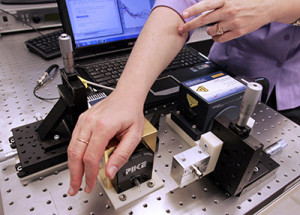 This isn’t so much about a current wearable product, but we’re betting it’s a technology you’ll be seeing pretty soon. Researchers at Princeton University have developed a new approach that uses mid-infrared light to measure blood glucose levels without the need for a blood stick.
This isn’t so much about a current wearable product, but we’re betting it’s a technology you’ll be seeing pretty soon. Researchers at Princeton University have developed a new approach that uses mid-infrared light to measure blood glucose levels without the need for a blood stick.
Wearables that monitor heart rate typically use LEDs that transmit near-infrared light, with a wavelength somewhere around 1 micron. That’s the type of light used in fiber optic communication, which is why it’s been miniaturized and is easily available. The wavelength of mid-infrared light, however, is between 3 and 8 microns, and is typically what heat-seeking missiles home in on. It requires more energy to generate than near-infrared does, which makes miniaturization more difficult. That’s one of the next steps for researchers.
Accuracy of the readings is not as good as with a blood stick but is apparently well within medically accepted standards.
So you won’t see stickless glucose monitoring in a wearable anytime soon. But scientists are clearly working on it.
The research was published July 1 in the journal Biomedical Optics Express (and we know you were just about to get around to reading that, right?). Here’s the press release about it from Princeton, which came out late this week.